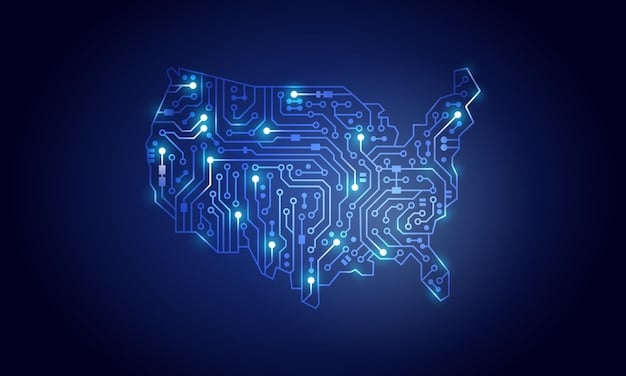US Cybersecurity Threats: National Security Response

The US is actively bolstering its cybersecurity defenses against national security threats through comprehensive strategies, including enhanced inter-agency collaboration, critical infrastructure protection, and significant investments in advanced technologies like AI and quantum computing, alongside international partnerships.
In a world increasingly defined by digital interconnectedness, the question of How is the US Addressing the Growing Cybersecurity Threats to National Security? has become paramount. From sophisticated state-sponsored attacks to insidious ransomware campaigns, the digital landscape presents a relentless barrage of challenges that directly impact America’s security, economy, and way of life.
The evolving landscape of cyber threats
The digital realm, while offering unparalleled connectivity and innovation, simultaneously introduces vulnerabilities that nation-states, non-state actors, and cybercriminals are quick to exploit. Understanding the multifaceted nature of these threats is the first step in formulating an effective defense. The sheer volume and sophistication of cyberattacks have grown exponentially, targeting everything from sensitive government data to essential public services.
Cyber threats are no longer confined to data breaches; they encompass a terrifying spectrum that includes espionage, intellectual property theft, disinformation campaigns, and even direct attacks on critical infrastructure. These incidents can cripple economies, sow public distrust, and undermine national defense capabilities. The challenge lies in the anonymous and often geographically dispersed nature of these adversaries, making attribution and response inherently complex.
State-sponsored cyber espionage and sabotage
Many of the most advanced and persistent cyber threats originate from state-sponsored entities. These groups possess significant resources, technical prowess, and often operate with the implicit or explicit backing of their governments. Their motives vary widely, from intelligence gathering to geopolitical disruption. Such actors target sensitive government networks, defense contractors, and high-tech industries to gain strategic advantages.
- Espionage: Stealing classified information, military intelligence, and diplomatic communications.
- Intellectual property theft: Acquiring trade secrets and proprietary technologies for economic benefit.
- Infrastructural disruption: Pre-positioning in critical infrastructure networks for potential future attacks.
The sophisticated nature of these attacks often involves zero-day exploits and custom malware, making them exceptionally difficult to detect and mitigate. The line between espionage and sabotage often blurs, as pre-positioning access can quickly turn into destructive actions if geopolitical tensions escalate.
Ransomware and cybercrime syndicates
Beyond state actors, large-scale cybercrime syndicates pose a significant threat, increasingly adopting tactics previously exclusive to nation-states. Ransomware, in particular, has emerged as a pervasive and lucrative form of attack, extorting billions from businesses, hospitals, and even municipal governments. These groups operate often from safe havens, leveraging cryptocurrencies for illicit gains and making law enforcement intervention challenging.
The economic impact of ransomware is staggering, leading to business disruptions, significant recovery costs, and potential data loss. The interconnectedness of supply chains means that a ransomware attack on one entity can cascade and affect many others, amplifying its disruptive power. These groups are constantly evolving their tactics, employing sophisticated social engineering and exploiting unpatched vulnerabilities.
Comprehensive strategies for cybersecurity defense
The US government recognizes that a fragmented approach to cybersecurity is insufficient. Consequently, it has developed and continues to refine a comprehensive national cybersecurity strategy that involves multiple layers of defense, proactive measures, and robust partnerships. This strategy goes beyond mere reactive defense, aiming to build resilience and deter future attacks across both government and private sectors.
Central to this strategy is the understanding that cybersecurity is a shared responsibility, requiring close collaboration between federal agencies, state and local governments, the private sector, and international allies. It emphasizes a layered defense in depth, from strong encryption and access controls to advanced threat intelligence sharing and rapid incident response capabilities. The goal is to make the digital environment less hospitable for malicious actors.
Strengthening federal and critical infrastructure security
Protecting federal networks and critical infrastructure is a top priority. Various directives and initiatives aim to enhance the cybersecurity posture of government agencies and the 16 critical infrastructure sectors. This includes mandatory implementation of advanced cybersecurity frameworks, continuous monitoring, and regular vulnerability assessments. The focus is on preventing breaches, but also on quickly detecting and responding to them when they occur.
- NIST Framework: Promoting the adoption of the National Institute of Standards and Technology (NIST) Cybersecurity Framework across federal agencies and critical infrastructure operators.
- Binding Operational Directives: Issuing mandatory directives to federal agencies for addressing specific cybersecurity vulnerabilities.
- Information Sharing and Analysis Centers (ISACs): Facilitating threat intelligence sharing between government and private sector entities within critical infrastructure sectors.
The emphasis on a “security by design” approach encourages incorporating cybersecurity considerations from the outset of system development, rather than as an afterthought. This proactive stance aims to reduce the attack surface and build more resilient systems from the ground up.

Enhanced inter-agency collaboration and coordination
Addressing complex cyber threats requires seamless cooperation across a multitude of government entities. No single agency possesses all the necessary insights, authorities, or resources to tackle the full spectrum of cyber challenges. Therefore, the US has significantly invested in fostering better collaboration and coordination among its diverse cybersecurity stakeholders.
Key agencies involved include the Department of Homeland Security (DHS), the Cybersecurity and Infrastructure Security Agency (CISA), the National Security Agency (NSA), the Federal Bureau of Investigation (FBI), and the Department of Defense (DoD), among others. Each brings unique capabilities and mandates to the national cybersecurity effort, collaboratively strengthening the nation’s digital defenses.
CISA plays a pivotal role as the nation’s civilian cybersecurity agency, working with partners to defend against today’s threats and build more secure infrastructure for tomorrow. It serves as a central hub for sharing threat intelligence, providing technical assistance, and issuing alerts to both government and private sector entities. The agency’s focus is on operational collaboration and helping organizations manage cyber risks effectively.
The FBI leads investigations into cybercrime and nation-state cyber intrusions, leveraging its law enforcement authorities to arrest and disrupt malicious actors. The NSA, responsible for signals intelligence and cybersecurity for national security systems, brings deep technical expertise in sophisticated cyber operations and defense. This intricate web of cooperation ensures a multi-pronged approach to threat detection, mitigation, and attribution.
Investing in advanced technologies and research
The nature of cyber threats is constantly evolving, driven by rapid advancements in technology. To stay ahead of adversaries, the US recognizes the imperative of continuous innovation and strategic investment in cutting-edge technologies. This includes not only defensive tools but also offensive capabilities to deter and respond to attacks effectively.
Significant resources are being channeled into research and development in areas such as artificial intelligence (AI), machine learning (ML), quantum computing, and advanced encryption techniques. These technologies hold the promise of revolutionizing cybersecurity defenses, enabling faster threat detection, more accurate anomaly identification, and more resilient cryptographic systems. The goal is to develop capabilities that can defend against the threats of tomorrow.
Leveraging artificial intelligence and machine learning
AI and ML are transforming cybersecurity by enabling automated threat detection, rapid incident response, and predictive analytics. These technologies can process vast amounts of data, identify patterns indicative of malicious activity, and even anticipate potential attacks. They are becoming indispensable in sifting through the noise to find genuine threats in complex network environments.
- Automated threat detection: AI-powered systems can identify anomalous behaviors and indicators of compromise far more quickly than human analysts.
- Vulnerability scanning: ML algorithms can learn from past exploits to predict and identify new vulnerabilities in software and systems.
- Malware analysis: AI can rapidly analyze new strains of malware, understand their capabilities, and develop countermeasures.
However, the adoption of AI in cybersecurity also presents unique challenges, including the need for robust, unbiased datasets and the potential for adversarial AI attacks. Therefore, research focuses not only on developing these tools but also on ensuring their security and reliability.
Exploring quantum-resistant cryptography
The advent of quantum computing poses a long-term, existential threat to current cryptographic standards. A sufficiently powerful quantum computer could, in theory, break many of the encryption algorithms currently used to secure sensitive data, communications, and financial transactions. Recognizing this future challenge, the US is actively investing in quantum-resistant cryptography research.
This includes the development of new cryptographic algorithms that are secure against attacks from both classical and quantum computers. The standardization of these post-quantum cryptography (PQC) algorithms is a critical step in preparing for a quantum-enabled future. The transition to PQC will be a massive undertaking, requiring years of effort to update existing systems and infrastructure to new standards.
The stakes are incredibly high, as the security of national secrets, military communications, and critical infrastructure depends on resilient encryption. The proactive approach to PQC underscores the long-term vision of US cybersecurity strategy, looking decades ahead to anticipate and mitigate future vulnerabilities before they materialize.
International cooperation and norm-building
Cyber threats transcend national borders, making international cooperation an indispensable component of any effective cybersecurity strategy. The US actively engages with allies and partners to share threat intelligence, coordinate responses, and promote responsible state behavior in cyberspace. This collective approach is essential for deterring malicious actors and enforcing international norms.
Bilateral and multilateral agreements, joint exercises, and diplomatic efforts form the cornerstone of this international engagement. By working together, nations can build a stronger collective defense, share best practices, and hold accountable those who launch cyberattacks from foreign soil. This collaborative framework fosters a shared understanding of threats and a unified front against cyber adversaries.
Building alliances and partnerships
The US has strengthened its cybersecurity alliances with key partners like the Five Eyes nations (Australia, Canada, New Zealand, and the United Kingdom), NATO, and the European Union. These partnerships involve regular exchanges of threat intelligence, joint training exercises, and coordinated diplomatic responses to significant cyber incidents. Such alliances provide a robust network for collective defense and mutual support.
Beyond traditional alliances, the US also seeks to build cybersecurity capacity in developing nations and engage with a broader range of countries to promote a stable and secure cyberspace. This involves providing technical assistance, sharing expertise, and supporting the development of national cybersecurity frameworks in partner countries. The goal is to raise the global baseline of cybersecurity hygiene.
Promoting responsible state behavior in cyberspace
A critical aspect of international cybersecurity efforts is the development and promotion of international norms for responsible state behavior in cyberspace. The US advocates for a framework that outlines acceptable and unacceptable actions of states in the digital realm, based on existing international law. This includes principles such as not attacking critical infrastructure, respecting data sovereignty, and providing assistance to victims of cyberattacks.
Through forums like the United Nations and bilateral dialogues, the US works to build consensus on these norms and to establish mechanisms for accountability. The principle of attribution—identifying the perpetrators of cyberattacks—is central to enforcing these norms and deterring future malicious activity. Diplomatic engagement is crucial in shaping the future of cyberspace governance and ensuring stability.
Cyber workforce development and public awareness
Even the most advanced technologies and robust strategies are ineffective without a skilled workforce to implement and manage them. The US faces a significant talent gap in the cybersecurity field, with demand far outstripping the supply of qualified professionals. Addressing this shortage is a critical long-term investment in national cybersecurity.
Alongside workforce development, raising public awareness about cybersecurity risks is equally vital. Individual citizens and small businesses are often the weakest links in the security chain, making them prime targets for phishing scams, malware, and other cybercrimes. Educating the public about best practices helps to create a more resilient digital ecosystem from the ground up.
Addressing the cyber talent shortage
Multiple initiatives are underway to cultivate a robust pipeline of cybersecurity talent. This includes promoting STEM education from an early age, supporting university cybersecurity programs, offering scholarships and internships, and providing pathways for military veterans to transition into civilian cybersecurity roles. Investing in professional development and continuous learning for the existing workforce is also paramount.
Bridging the skills gap requires a multi-faceted approach, engaging academia, industry, and government. Programs like the Cybersecurity Education and Training Assistance Program (CETAP) and the National Initiative for Cybersecurity Education (NICE) are foundational in building this national capacity. The focus is on developing both technical skills and critical thinking necessary to adapt to evolving threats.
There’s also a growing recognition of the need for diversity in the cybersecurity workforce, bringing varied perspectives and problem-solving approaches to complex challenges. Efforts are being made to attract and retain individuals from underrepresented groups, further strengthening the nation’s human capital in this critical domain.
Promoting cyber hygiene and public education
Public awareness campaigns emphasize fundamental cyber hygiene practices, such as strong password usage, multi-factor authentication, recognizing phishing attempts, and keeping software updated. These seemingly simple measures can significantly reduce the attack surface for cyber criminals and enhance overall national digital resilience.
Government agencies and non-profit organizations provide resources and guidance for individuals and small businesses to protect themselves online. This includes digestible information on common cyber threats and practical steps to mitigate risks. The aim is to empower every internet user to be a proactive participant in their own cybersecurity, collectively raising the nation’s defensive posture.
Regular campaigns, such as Cybersecurity Awareness Month, play a crucial role in disseminating this information and reinforcing best practices. The emphasis is on making cybersecurity a routine part of digital citizenship, much like physical safety precautions. This widespread adoption of basic security habits significantly strengthens the overall ecosystem against opportunistic attacks.
Challenges and future outlook
Despite significant progress, the US still faces formidable challenges in its cybersecurity endeavors. The adversarial landscape is dynamic, with threats constantly evolving in sophistication and scale. The sheer volume of interconnected devices, the speed of technological change, and the geopolitical complexities of cyberspace mean that the fight for digital security is a continuous marathon, not a sprint.
One persistent challenge is talent retention, as skilled cybersecurity professionals are highly sought after by both the public and private sectors, often commanding higher salaries in the latter. Adapting regulatory frameworks to keep pace with technological advancements also presents a significant hurdle. Furthermore, maintaining a balance between security measures and privacy concerns remains a delicate act, requiring careful navigation of policy and public expectations.
Maintaining a strategic advantage
Staying ahead requires continuous investment in research and development, fostering innovation, and anticipating future threats. This includes exploring emerging technologies like artificial general intelligence (AGI) and post-quantum cryptography to understand their potential impact on cybersecurity, both as tools for defense and as potential new vectors for attack. The race for technological superiority is ongoing.
A strategic advantage also relies on robust intelligence gathering and analysis to accurately attribute attacks and understand adversary capabilities and intentions. This involves sophisticated technical analysis combined with traditional human intelligence. The ability to deter and respond effectively hinges on having a clear and timely understanding of the threat landscape.

Adapting to geopolitical shifts
The geopolitical landscape significantly influences cybersecurity threats, with tensions between nation-states often manifesting in the cyber domain. Events like conflicts and political disputes can trigger an escalation in cyberattacks, targeting critical infrastructure or spreading disinformation. The US must remain agile in its foreign policy and cybersecurity posture to adapt to these rapid shifts.
This includes strengthening international alliances, collaborating on joint cyber operations, and building a global consensus against malicious cyber activities. Diplomacy plays a crucial role in establishing red lines and reinforcing norms, but deterrence also involves demonstrating credible response capabilities to dissuade potential adversaries. The interplay between traditional geopolitics and the digital realm is becoming increasingly intertwined, demanding a holistic approach.
The future of cybersecurity for national security will likely involve even greater integration of AI into defensive systems, widespread adoption of zero-trust architectures, and a sustained focus on supply chain security. The continuous development of a skilled workforce and enhanced public awareness will remain foundational elements in building a truly resilient digital nation, capable of weathering the ever-growing storm of cyber threats. It’s a testament to ongoing commitment and adaptability.
| Key Area | Brief Description |
|---|---|
| 🛡️ Strategic Defense | Multi-layered defense, critical infrastructure protection, and proactive measures across public and private sectors. |
| 🤝 Collaboration | Enhanced inter-agency cooperation (CISA, FBI, NSA) and strong international partnerships (NATO, Five Eyes). |
| 💡 Tech Investment | Significant R&D in AI/ML for threat detection and quantum-resistant cryptography for future security. |
| 🧑💻 Workforce & Public | Initiatives to close the cyber talent gap and educate the public on essential cyber hygiene practices. |
Frequently asked questions (FAQ)
▼
The US faces a range of advanced cyber threats, primarily from state-sponsored actors conducting espionage, intellectual property theft, and critical infrastructure pre-positioning. Additionally, rampant cybercrime, particularly ransomware led by organized syndicates, poses significant economic and operational risks. Disinformation campaigns also aim to sow discord and undermine democratic processes, all impacting national security.
▼
Protection of critical infrastructure involves multidisciplinary efforts. The Cybersecurity and Infrastructure Security Agency (CISA) plays a lead role, promoting cybersecurity frameworks like NIST, issuing binding operational directives, and facilitating information sharing via ISACs. Collaboration between government and private sector operators is crucial for continuous monitoring, vulnerability assessments, and rapid incident response to defend these vital systems.
▼
Advanced technologies, especially AI and machine learning, are integral to enhancing cybersecurity. They enable automated threat detection, allowing rapid identification of malicious activities in vast datasets. AI assists in predictive analytics, anticipating potential attacks, and efficient malware analysis. These tools augment human capabilities, providing a significant advantage in the ongoing effort to defend against evolving cyber threats.
▼
International cooperation is vital given the borderless nature of cyber threats. The US engages through bilateral and multilateral alliances such as NATO and the Five Eyes nations, sharing threat intelligence, coordinating responses, and conducting joint cyber exercises. It also promotes international norms for responsible state behavior in cyberspace, advocating for accountability and stability in the global digital landscape.
▼
Addressing the cybersecurity talent gap is a national priority. Initiatives include promoting STEM education, supporting university programs, offering scholarships, and creating pathways for veterans. Programs like NICE (National Initiative for Cybersecurity Education) aim to build a robust pipeline of skilled professionals, ensuring the nation has the human capital necessary to defend its digital infrastructure against ever-increasing cyber threats.
Conclusion
The multifaceted approach adopted by the US to counter growing cybersecurity threats reflects a deep understanding of the digital landscape’s complexities. By combining robust technological investments, unprecedented inter-agency and international collaboration, and a strategic focus on workforce development and public awareness, the nation is building a formidable defense. While the challenges remain dynamic and persistent, the continuous adaptation and proactive strategies underline a commitment to securing national security in an increasingly interconnected and vulnerable digital world. This ongoing effort is critical to safeguarding America’s infrastructure, economy, and way of life.





